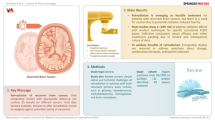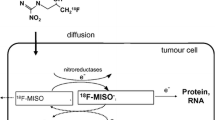Abstract
Purpose
The prognosis of patients with recurrent gliomas depends on reliable and early diagnosis of tumour recurrence after initial therapy. In this context, magnetic resonance imaging (MRI) and computed tomography (CT) often fail to differentiate between radiation- and tumour-induced contrast enhancement. Furthermore, absence of contrast enhancement, or even of 18F-fluorodeoxyglucose uptake in PET, does not exclude recurrence. The aim of this study was to establish the diagnostic value of O-(2-[18F]fluoroethyl)-l-tyrosine (FET) PET in recurrent gliomas.
Methods
Fifty-three patients with glioma (primary grading: 27=WHO grade IV, 16=grade III, 9=grade II, 1=grade I) and clinically suspected recurrence underwent FET PET scans 4–180 months after different treatment modalities. For semiquantitative evaluation, maximal SUV (SUVmax) and mean SUV within 80% and 70% isocontour thresholds (SUV80/SUV70) were evaluated and the respective ratios to the background (BG) were calculated. PET results were correlated with MRI/CT, clinical follow-up or biopsy findings.
Results
All patients presented with FET uptake, of varying intensity, in the area of the primary tumour after initial therapy. In the 42 patients with confirmed recurrence, there was additional distinct focal FET uptake with significantly higher values compared with those in the 11 patients without clinical signs of recurrence and showing only low and homogeneous FET uptake at the margins of the resection cavity. With respect to tumour grading, there was a slight but non-significant increase from WHO II (SUVmax/BG: 2.53±0.28) to WHO III (SUVmax/BG: 2.84±0.49) and WHO IV (SUVmax/BG: 3.55±1.07) recurrence.
Conclusion
FET PET reliably distinguishes between post-therapeutic benign lesions and tumour recurrence after initial treatment of low- and high-grade gliomas.


Similar content being viewed by others
References
Goetz C, Riva P, Poepperl G, Gildehaus FJ, Hischa A, Tatsch K, Reulen HJ. Locoregional radioimmunotherapy in selected patients with malignant glioma: experiences, side effects and survival times. J Neurooncol 2003;62:321–8.
Westphal M, Lamszus K, Hilt D. Intracavitary chemotherapy for glioblastoma: present status and future directions. Acta Neurochir Suppl 2003;88:61–7.
Kelly PJ, Daumas-Duport C, Kispert DB, Kall BA, Scheithauer BW, Illig JJ. Imaging-based stereotaxic serial biopsies in untreated intracranial glial neoplasms. J Neurosurg 1987;66:865–74.
Nelson SJ. Imaging of brain tumors after therapy. Neuroimaging Clin North Am 1999;9:801–19.
Valk PE, Dillon WP. Radiation injury of the brain. Am J Neuroradiol 1991;12:45–62.
Earnest FT, Kelly PJ, Scheithauer BW, Kall BA, Cascino TL, Ehman RL, et al. Cerebral astrocytomas: histopathologic correlation of MR and CT contrast enhancement with stereotactic biopsy. Radiology 1988;166:823–7.
Chamberlain MC, Murovic JA, Levin VA. Absence of contrast enhancement on CT brain scans of patients with supratentorial malignant gliomas. Neurology 1988;38:1371–4.
Di Chiro G. Positron emission tomography using [18F]fluorodeoxyglucose in brain tumors. A powerful diagnostic and prognostic tool. Invest Radiol 1987;22:360–71.
Patronas NJ, Di Chiro G, Brooks RA, DeLaPaz RL, Kornblith PL, Smith BH, et al. Work in progress: [18F] fluorodeoxyglucose and positron emission tomography in the evaluation of radiation necrosis of the brain. Radiology 1982;144:885–9.
Di Chiro G, Oldfield E, Wright DC, De Michele D, Katz DA, Patronas NJ, et al. Cerebral necrosis after radiotherapy and/or intraarterial chemotherapy for brain tumors: PET and neuropathologic studies. Am J Roentgenol 1988;150:189–97.
Valk PE, Budinger TF, Levin VA, Silver P, Gutin PH, Doyle WK. PET of malignant cerebral tumors after interstitial brachytherapy. Demonstration of metabolic activity and correlation with clinical outcome. J Neurosurg 1988;69:830–8.
Ogawa T, Kanno I, Shishido F, Inugami A, Higano S, Fujita H, et al. Clinical value of PET with 18F-fluorodeoxyglucose and l-methyl-11C-methionine for diagnosis of recurrent brain tumor and radiation injury. Acta Radiol 1991;32:197–202.
Olivero WC, Dulebohn SC, Lister JR. The use of PET in evaluating patients with primary brain tumours: is it useful? J Neurol Neurosurg Psychiatry 1995;58:250–2.
Ricci PE, Karis JP, Heiserman JE, Fram EK, Bice AN, Drayer BP. Differentiating recurrent tumor from radiation necrosis: time for re-evaluation of positron emission tomography? Am J Neuroradiol 1998;19:407–13.
Laverman P, Boerman OC, Corstens FH, Oyen WJ. Fluorinated amino acids for tumour imaging with positron emission tomography. Eur J Nucl Med Mol Imaging 2002;29:681–90.
Herholz K, Holzer T, Bauer B, Schroder R, Voges J, Ernestus RI, et al. 11C-methionine PET for differential diagnosis of low-grade gliomas. Neurology 1998;50:1316–22.
Pruim J, Willemsen AT, Molenaar WM, van Waarde A, Paans AM, Heesters MA, et al. Brain tumors: l-[1-C-11]tyrosine PET for visualization and quantification of protein synthesis rate. Radiology 1995;197:221–6.
Derlon JM, Bourdet C, Bustany P, Chatel M, Theron J, Darcel F, Syrota A. [11C]l-methionine uptake in gliomas. Neurosurgery 1989;25:720–8.
Mosskin M, Ericson K, Hindmarsh T, von Holst H, Collins VP, Bergstrom M, et al. Positron emission tomography compared with magnetic resonance imaging and computed tomography in supratentorial gliomas using multiple stereotactic biopsies as reference. Acta Radiol 1989;30:225–32.
Ogawa T, Shishido F, Kanno I, Inugami A, Fujita H, Murakami M, et al. Cerebral glioma: evaluation with methionine PET. Radiology 1993;186:45–53.
Thiel A, Pietrzyk U, Sturm V, Herholz K, Hovels M, Schroder R. Enhanced accuracy in differential diagnosis of radiation necrosis by positron emission tomography–magnetic resonance imaging coregistration: technical case report. Neurosurgery 2000;46:232–4.
Tsuyuguchi N, Sunada I, Iwai Y, Yamanaka K, Tanaka K, Takami T, et al. Methionine positron emission tomography of recurrent metastatic brain tumor and radiation necrosis after stereotactic radiosurgery: is a differential diagnosis possible? J Neurosurg 2003;98:1056–64.
Wester HJ, Herz M, Weber W, Heiss P, Senekowitsch-Schmidtke R, Schwaiger M, Stocklin G. Synthesis and radiopharmacology of O-(2-[18F]fluoroethyl)-l-tyrosine for tumor imaging. J Nucl Med 1999;40:205–12.
Heiss P, Mayer S, Herz M, Wester HJ, Schwaiger M, Senekowitsch-Schmidtke R. Investigation of transport mechanism and uptake kinetics of O-(2-[18F]fluoroethyl)-l-tyrosine in vitro and in vivo. J Nucl Med 1999;40:1367–73.
Weber WA, Wester HJ, Grosu AL, Herz M, Dzewas B, Feldmann HJ, et al. O-(2-[18F]fluoroethyl)-l-tyrosine and l-[methyl-11C]methionine uptake in brain tumours: initial results of a comparative study. Eur J Nucl Med 2000;27:542–9.
Miyagawa T, Oku T, Uehara H, Desai R, Beattie B, Tjuvajev J, Blasberg R. “Facilitated” amino acid transport is upregulated in brain tumors. J Cereb Blood Flow Metab 1998;18:500–9.
Pauleit D, Floeth F, Herzog H, Hamacher K, Tellmann L, Muller HW, et al. Whole-body distribution and dosimetry of O-(2-[18F]fluoroethyl)-l-tyrosine. Eur J Nucl Med Mol Imaging 2003;30:519–24.
Sato N, Inoue T, Tomiyoshi K, Aoki J, Oriuchi N, Takahashi A, et al. Gliomatosis cerebri evaluated by 18Fα-methyl tyrosine positron-emission tomography. Neuroradiology 2003;45:700–7.
Inoue T, Shibasaki T, Oriuchi N, Aoyagi K, Tomiyoshi K, Amano S, et al. 18F alpha-methyl tyrosine PET studies in patients with brain tumors. J Nucl Med 1999;40:399–405.
Becherer A, Karanikas G, Szabo M, Zettinig G, Asenbaum S, Marosi C, et al. Brain tumour imaging with PET: a comparison between [18F]fluorodopa and [11C]methionine. Eur J Nucl Med Mol Imaging 2003;30:1561–7.
Beuthien-Baumann B, Bredow J, Burchert W, Fuchtner F, Bergmann R, Alheit HD, et al. 3-O-methyl-6-[18F]fluoro-l-DOPA and its evaluation in brain tumour imaging. Eur J Nucl Med Mol Imaging 2003;30:1004–8.
Hara T, Kondo T, Kosaka N. Use of 18F-choline and 11C-choline as contrast agents in positron emission tomography imaging-guided stereotactic biopsy sampling of gliomas. J Neurosurg 2003;99:474–9.
Uehara H, Miyagawa T, Tjuvajev J, Joshi R, Beattie B, Oku T, et al. Imaging experimental brain tumors with 1-aminocyclopentane carboxylic acid and alpha-aminoisobutyric acid: comparison to fluorodeoxyglucose and diethylenetriaminepentaacetic acid in morphologically defined tumor regions. J Cereb Blood Flow Metab 1997;17:1239–53.
Wienhard K, Herholz K, Coenen HH, Rudolf J, Kling P, Stocklin G, Heiss WD. Increased amino acid transport into brain tumors measured by PET of l-(2-18F)fluorotyrosine. J Nucl Med 1991;32:1338–46.
Bergstrom M, Ericson K, Hagenfeldt L, Mosskin M, von Holst H, Noren G, et al. PET study of methionine accumulation in glioma and normal brain tissue: competition with branched chain amino acids. J Comput Assist Tomogr 1987;11:208–13.
Kracht LW, Friese M, Herholz K, Schroeder R, Bauer B, Jacobs A, Heiss WD. Methyl-[11C]-l-methionine uptake as measured by positron emission tomography correlates to microvessel density in patients with glioma. Eur J Nucl Med Mol Imaging 2003;30:868–73.
Kaim AH, Weber B, Kurrer MO, Westera G, Schweitzer A, Gottschalk J, et al. 18F-FDG and 18F-FET uptake in experimental soft tissue infection. Eur J Nucl Med Mol Imaging 2002;29:648–54.
Author information
Authors and Affiliations
Corresponding author
Rights and permissions
About this article
Cite this article
Pöpperl, G., Götz, C., Rachinger, W. et al. Value of O-(2-[18F]fluoroethyl)-l-tyrosine PET for the diagnosis of recurrent glioma. Eur J Nucl Med Mol Imaging 31, 1464–1470 (2004). https://doi.org/10.1007/s00259-004-1590-1
Received:
Accepted:
Published:
Issue Date:
DOI: https://doi.org/10.1007/s00259-004-1590-1




